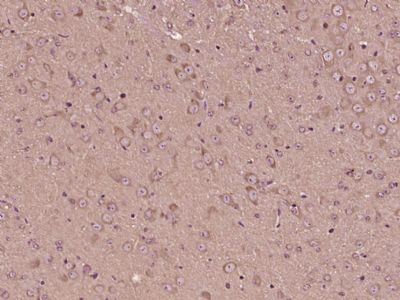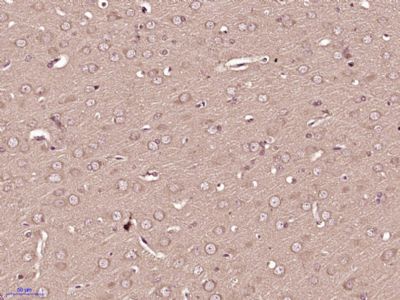TRPM3 Polyclonal Antibody
Purified Rabbit Polyclonal Antibody (Pab)
- 产品详情
- 实验流程
Application
| IHC-P, IHC-F, IF, E |
|---|---|
| Primary Accession | Q9HCF6 |
| Reactivity | Rat, Pig, Dog, Bovine |
| Host | Rabbit |
| Clonality | Polyclonal |
| Calculated MW | 197571 Da |
| Gene ID | 80036 |
|---|---|
| Other Names | Transient receptor potential cation channel subfamily M member 3, Long transient receptor potential channel 3, LTrpC-3, LTrpC3, Melastatin-2, MLSN2, TRPM3, KIAA1616, LTRPC3 |
| Dilution | IHC-P=1:100-500,IHC-F=1:100-500,IF=1:50-200,ELISA=1:5000-10000 |
| Format | 0.01M TBS(pH7.4) with 1% BSA, 0.09% (W/V) sodium azide and 50% Glyce |
| Storage | Store at -20 °C for one year. Avoid repeated freeze/thaw cycles. When reconstituted in sterile pH 7.4 0.01M PBS or diluent of antibody the antibody is stable for at least two weeks at 2-4 °C. |
| Name | TRPM3 (HGNC:17992) |
|---|---|
| Synonyms | KIAA1616, LTRPC3 |
| Function | Constitutively active, non-selective divalent cation- conducting channel that is permeable to Ca(2+), Mn(2+), and Mg(2+), with a high permeability for Ca(2+). However, can be enhanced by increasing temperature and by ligands, including the endogenous neurosteroid pregnenolone sulfate and sphingosine-1 and suppressed by intracellular Mg(2+) (PubMed:12672799, PubMed:12672827, PubMed:32343227). Implicated in a variety of cellular processes, including insulin/peptide secretion, vascular constriction and dilation, noxious heat sensing, inflammatory and spontaneous pain sensitivity. In neurons of the dorsal root ganglia, functions as thermosensitive channel for the detection of noxious heat and spontaneous pain. Suggested to function as an ionotropic steroid receptor in beta-cell, indeed pregnenolone sulfate leads to Ca(2+) influx and enhanced insulin secretion. Mediates Zn(2+) uptake into the lumen of pancreatic beta cell secretory granules, thereby regulating insulin secretion (By similarity). Forms heteromultimeric ion channels with TRPM1 which are permeable for Ca(2+) and Zn(2+) ions (PubMed:21278253). Exists as multiple splice variants which differ significantly in their biophysical properties (By similarity). |
| Cellular Location | Cell membrane; Multi-pass membrane protein {ECO:0000250|UniProtKB:J9SQF3} |
| Tissue Location | Expressed primarily in the kidney and, at lower levels, in brain, testis, ovary, pancreas and spinal cord. Expression in the brain and kidney was determined at protein level. In the kidney, expressed predominantly in the collecting tubular epithelium in the medulla, medullary rays, and periglomerular regions; in the brain, highest levels are found in the cerebellum, choroid plexus, the locus coeruleus, the posterior thalamus and the substantia nigra. Down- regulated in renal tumors compared to normal kidney. Expressed in the lens (PubMed:25090642). |
Research Areas
For Research Use Only. Not For Use In Diagnostic Procedures.
Application Protocols
Provided below are standard protocols that you may find useful for product applications.
终于等到您。ABCEPTA(百远生物)抗体产品。
点击下方“我要评价 ”按钮提交您的反馈信息,您的反馈和评价是我们最宝贵的财富之一,
我们将在1-3个工作日内处理您的反馈信息。
如有疑问,联系:0512-88856768 tech-china@abcepta.com.























 癌症的基本特征包括细胞增殖、血管生成、迁移、凋亡逃避机制和细胞永生等。找到癌症发生过程中这些通路的关键标记物和对应的抗体用于检测至关重要。
癌症的基本特征包括细胞增殖、血管生成、迁移、凋亡逃避机制和细胞永生等。找到癌症发生过程中这些通路的关键标记物和对应的抗体用于检测至关重要。 为您推荐一个泛素化位点预测神器——泛素化分析工具,可以为您的蛋白的泛素化位点作出预测和评分。
为您推荐一个泛素化位点预测神器——泛素化分析工具,可以为您的蛋白的泛素化位点作出预测和评分。 细胞自噬受体图形绘图工具为你的蛋白的细胞受体结合位点作出预测和评分,识别结合到自噬通路中的蛋白是非常重要的,便于让我们理解自噬在正常生理、病理过程中的作用,如发育、细胞分化、神经退化性疾病、压力条件下、感染和癌症。
细胞自噬受体图形绘图工具为你的蛋白的细胞受体结合位点作出预测和评分,识别结合到自噬通路中的蛋白是非常重要的,便于让我们理解自噬在正常生理、病理过程中的作用,如发育、细胞分化、神经退化性疾病、压力条件下、感染和癌症。







